Amonkhet Down to Business, Part 3
For the last two weeks, I've been talking about how Amonkhet got designed (Part 1 and Part 2). I explained that it was a top-down design (and if you want more detail on what exactly that means, check out my "Drive to Work" podcast at the end of this article) based on capturing two things—Egyptian mythology and Nicol Bolas. I've talked all about how the design tried to capture top-down Egyptian influences, so today I will talk about the other half: how the design of the set was shaped by top-down Nicol Bolas influences.
Stop Dragon My Heart Around
To figure out how to do a top-down design on Nicol Bolas, we first had to do a little research on the Elder Dragon himself. Ethan Fleischer, my co-lead designer on the set, has long been a fan of Magic's lore and knew quite a bit about Nicol Bolas, which he shared with the team. This led us to choose five adjectives that best describe Nicol Bolas:
- Cruel
- Manipulative
- Intelligent
- Ancient
- Powerful
Let me walk through each one.
Cruel—One of the things that's clear by looking at the history of Bolas's actions is that he not only doesn't care who he hurts to get what he wants, but seems to derive satisfaction from the act of causing others pain. He doesn't rule through loyalty or vision; he rules through fear. Do what he says or suffer the consequences. Often, you will do what he says and suffer the consequences.
Manipulative—Bolas never lets you know what he's up to, only what objective he needs from you. One of the great mysteries of the character is that we've only gotten to see what he does and not why. It's clear though that each action he takes is part of a larger plan that only Bolas is aware of.
Intelligent—There are many reasons Bolas is dangerous, but probably the most important is that he's very smart. He understands that information is the most valuable commodity and has spent years collecting it. Each action he takes has been carefully thought out and plotted many steps ahead.
Ancient—Bolas is over 25,000 years old. He earns the "Elder" in Elder Dragon. Part of what makes him so dangerous is the amount of wisdom and experience he's accumulated over the years. He's seen it all and will definitely use that knowledge to his advantage.
Powerful—For starters, Bolas is a Dragon, and a pretty big Dragon at that. He's also a Planeswalker, a spellcaster, a puppet master, and a strategist. He's collected spells and objects from across the multiverse over centuries. He's probably the last being you'd ever want to face one-to-one in a fight.
Once we had the adjectives, the next step was figuring out how to represent that quality in the mechanics. Once again, I'll walk through each one.
Cruel
How do you make gameplay feel cruel? It just so happens we solved this problem a number of years earlier, ironically trying to find a way to make the gameplay feel less cruel.
The set was Lorwyn, and the idea behind it was that we were creating a plane with two mirrored states, one bright and kind and one dark and cruel. I liked the idea that creature kill wouldn't be so absolute, so I played around with trying to find a way to injure things rather than just kill them. Lorwyn wasn't the kind of place where someone would kill you, but rather maybe just beat you up a little.
To capture this, I made the following card:
Rough Them Up
1B
Sorcery
Put two -1/-1 counters on target creature.
The idea was that we could use -1/-1 counters to show that creatures were injured. This would allow us to convey the sense of creatures being harmed without being outright killed. The idea was that there would be ways to remove the counters, representing creatures being healed. The first Lorwyn playtest had a bunch of -1/-1 counter cards and we quickly learned something important—instead of getting a sense of things only being injured, the -1/-1 counters conveyed things being purposely tortured. "I could kill you, but instead I'll hurt you."
We ended up pushing the -1/-1 counters to Shadowmoor, the set that was supposed to feel dark and cruel. We then brought them back in Scars of Mirrodin block when we were trying to capture the feel of the Phyrexians, who we also wanted to feel cruel. -1/-1 counters had taken on a mechanical sense of cruelty. Flash forward to Amonkhet design. We wanted cruelty. That meant it was time to dust off the -1/-1 counters. Note that this overlapped with the sense of harshness that was a big part of Egyptian mythology. The deserts in particular were seen as a sign of the cruelty of the gods.
A quick aside. One of the rules we have in R&D is to limit counters on creatures to a single counter type (in common and uncommon; rare and mythic rare will occasionally have a unique counter type) to make it crystal clear in Limited what stats a particular creature has. For instance, in Amonkhet, if you see a 3/3 with a counter on it, you'll know it's a 2/2. This means that we don't often do -1/-1 counters except in blocks where we choose to do them instead of +1/+1 counters.
Once we made the decision to have -1/-1 counters be the counters in the block, the next decision was whether or not to have a mechanic or two that used them. Because we make use of -1/-1 counters so infrequently, this often opens design space we don't normally have access to. The first thing we tried, and it was something that stayed through design and was removed in development, was wither. Wither is a creature mechanic from Shadowmoor where a creature's damage to other creatures is converted to -1/-1 counters.
Our main locale on Amonkhet is a city called Naktamun. The city lies within a barrier that protects it from the dangers of the desert. (More on this in a second.) We decided to use wither solely on creatures from outside the barrier to represent the dangerous world that Naktamun was being protected from. Most of the creatures with wither were black mummies. (Remember, the white mummies are the servants inside the city and the black mummies are abominations from outside the city.)
We also messed around with a mechanic that made use of -1/-1 counters to represent the ruthlessness of Bolas, but it ended up not making the cut for Amonkhet. (More about this mechanic during Hour of Devastation previews—it's not in that set either as a keyword, but it did influence the design.)
Manipulative
One of my favorite parts of the Amonkhet story happens right at the beginning. The Gatewatch (minus Ajani) travels to the plane of Amonkhet to stop Nicol Bolas. Their assumption is that they're going to come to a dark, oppressed world whose people will be overjoyed to see the Gatewatch, as they will free them from the tyranny of Bolas. Instead, they arrive to find a bright, happy world where Bolas is beloved as a god. The people have no desired to be saved.
As the Gatewatch explores the city of Naktamun, they start to realize that something doesn't feel right. The world has a sense of dissonance. That is, the conscious messages on the surface don't seem to match the unconscious messages from below. Things look fine, but don't feel fine. We talked about how the film Stepford Wives and the book A Wrinkle in Time both have sequences where the protagonist sees that what is on the surface looks like an ideal place but feels a sense of discomfort as they can tell that their eyes and their guts aren't in sync.
This led us to work with the creative team to purposefully create a mechanical-creative dissonance. The mechanics would convey a darker, more sinister feel (such as the use of -1/-1 counters) but the creative would take a happier, more upbeat tone. That way what you saw on the cards and what you felt from the gameplay wouldn't line up. Like the Gatewatch, the players would get a sense that something isn't quite right as the contradicting inputs would create a sense of discomfort.
This would convey the idea that Bolas has manipulated the world in a way that the players could sense.
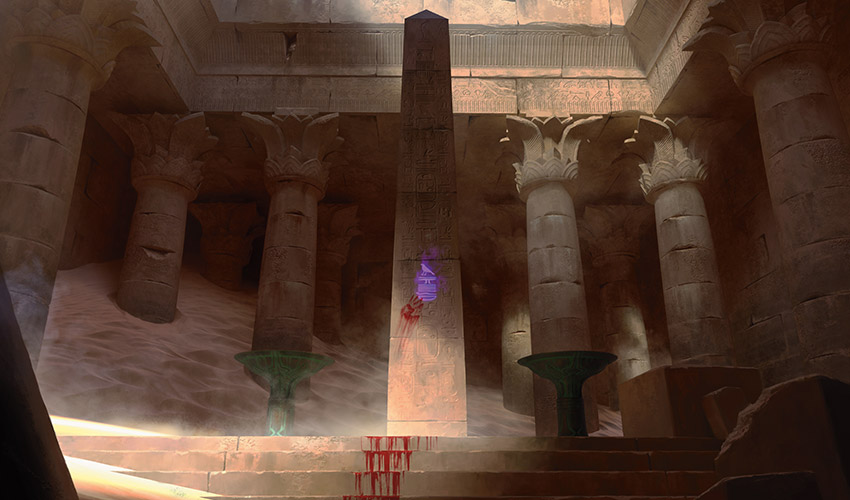
Intelligent
This attribute was in some ways easy and in others hard. It's not difficult to make Magic players feel smart. Magic's a game about choice and interaction. A normal game has countless opportunities for the players to feel clever. We wanted something that conveyed a sense of controlling things at a slightly higher level, though.
Meanwhile, the set, like most sets, was looking for what we call a "mana-smoothing component." While there are many great things about Magic's mana system, the ability to "mana screw" and not get enough land to use your spells is frustrating, so we like to give players tools to lessen that. Usually we do this by either making it easier to find your lands or by giving you things to do with excess mana, allowing you to play extra lands.
As I talked about last week, our first attempt to solve this was with a hieroglyphics mechanic, but it ended up being too close to investigate from Shadows over Innistrad, so we had to kill it. Around that time, Erik Lauer came up to me and Ethan and asked our opinion about cycling. The mechanic was created by Richard Garfield during Tempest design and first appeared in Urza's Saga block. It was then brought back twice: once during Time Spiral block and once in Shards of Alara block.
Cycling is an elegant and useful mechanic that does a great job of mana smoothing. It's only flaw is it doesn't have a lot of flavor. Erik was suggesting it for two reasons. One, he felt it would work well with other blocks in Standard, particularly Shadows over Innistrad. Two, he'd been dying to make a cycle of dual lands with cycling, and he thought this would be a good spot to make them.
The team had been trying to find something that conveyed the forethought and intelligence of Bolas, and we needed a mana smoother. That, along with the benefits that Erik pointed out, made cycling an easy choice to add to the set. We ended up putting cycling in all five colors and on the dual lands, along with adding a couple of cards in blue that interact with cycling cards.
Ancient
An important part of Bolas's character is his age. When you've lived as long as he has, you start thinking in a very different timeline from most people. Bolas's plans aren't constructed in days or months or even years. Bolas's plans elapse over decades and centuries. Amonkhet is no exception. When the Gatewatch arrive, they find a world that has a system locked in through tradition. This wasn't a hastily thrown-together plot. Bolas has created a world in which every aspect of the peoples' lives is controlled by a system he created—then he left while it self-perpetuated.
The world is built around five Trials that each inhabitant of the world aspires to complete. The five Trials are built around the five colors of Magic, and each one represents a different attribute that the Gods, and Bolas as God-Pharaoh, herald as important. Here are the Trials in the order that the citizens of Amonkhet complete them:
- The Trial of Solidarity (white)—This Trial tests your ability to work with others.
- The Trial of Knowledge (blue)—This Trial tests your mental capacity.
- The Trial of Strength (green)—This Trial tests your physical capacity.
- The Trial of Ambition (black)—This Trial tests your willingness to do what must be done.
- The Trial of Zeal (red)—This final Trial is a fight to the death.
In each Trial, failure results in death. Success brings an award known as a cartouche, an ornamental decoration, and an invitation to the next Trial. In the final Trial, if you are successful, you earn your cartouche and then are put to an honorable death by Hazoret, the red God.
The Trials, along with the cartouches, the Gods, and the monuments to the gods (where each Trial is held) were a design challenge for us to solve. For starters, we knew we wanted a five-card cycle for each. We knew each cycle had to flavorfully capture the essence of that element while also working in conjunction with one another. Finally, each had to capture the quality that that color tested in the Trials.
The design of the Gods came first. As I explained two weeks ago, players were going to expect Gods in a top-down Egyptian-inspired set, so we knew we had to deliver something cool. I talked about their design two weeks ago. They are legendary creatures with the God creature type. Next we designed the Monuments. I talked about their design last week. They are legendary artifacts made to be synergistic with their connected God.
The Trials began as non-legendary enchantments and with a design similar to the quests from Zendikar: achieve the task set out by the card, and you unlock a powerful effect. The Cartouches began as non-legendary Auras and granted abilities that enabled you to pass the associated Trial. We soon realized that this design was a little off, as the Cartouche was the reward for passing the Trial, not a means to aid you in completing it.
So, we tried a different version where the reward from completing the Trial was getting the associated Cartouche out of your deck. It was more flavorful but didn't play well. So, we (and at this point "we" becomes development rather than design) then tried a version where each Trial had an enters-the-battlefield effect and a Cartouche entering the battlefield returned the Trial to your hand—allowing it, and its effect, to be played again. I believe the earliest version required the proper-color Cartouche to be played, but we ended up lowering the requirement to any Cartouche to allow more interaction.
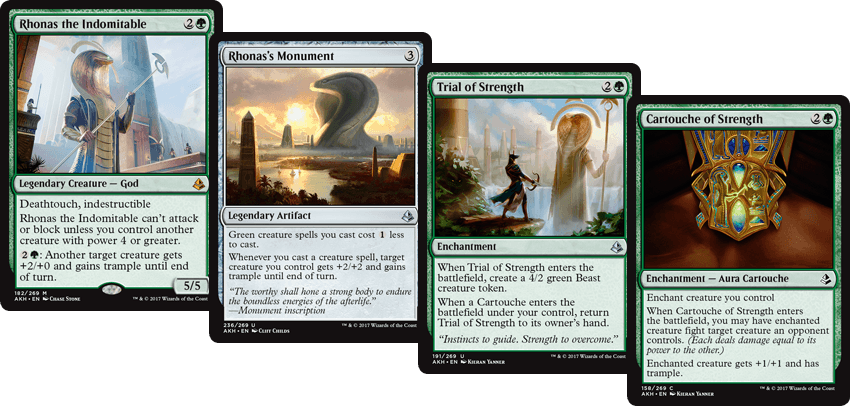
The Gods, Monuments, Trials, and Cartouches were designed to be synergistic with one another. Let's take the green God Rhonas as an example. I start by playing Rhonas's Monument on turn three. Then on turn four, I can play Trial of Strength. When it enters the battlefield, I get a 4/2 green Beast creature token. On turn five, I can cast both Rhonas the Indomitable and Cartouche of Strength. I cast Rhonas first for one mana cheaper because of his Monument. Rhonas is a creature, so he triggers the Monument, allowing me to turn the 4/2 Beast into a 6/4 creature that I can then attack with. The Beast also turns on Rhonas, who is now allowed to attack and block.
I then put Cartouche of Strength onto Rhonas, making him a 6/6 deathtouch, indestructible, trampler that can then fight with whatever creature I want to kill. The casting of the Cartouche returns the Trial to my hand. Then on the next turn, I recast the Trial getting another 4/2 Beast creature token. I then have mana to activate Rhonas ability to turn my preexisting 6/4 Beast into an 8/4 trampler and then get to attack with both Rhonas and the larger Beast for 14 points of damage, all on tramplers. If somehow that doesn't kill my opponent, on the next turn, I can activate Rhonas twice to turn both my 6/4 Beasts into 8/4 tramplers and can attack for 22 points of damage, again all with trample.
Powerful
The final piece to the puzzle came about when two very different threads eventually met. The first thread was a desire by us to figure out a way to demonstrate Bolas's power. We liked the idea that you, as the Planeswalker, could exert your power in some way over your creatures. You could essentially force them to do something that they might not want to do. This reminded me of a mechanic we had experimented with for the Gruul back in Gatecrash. We called it "reckless" and the idea was that a creature could upgrade themselves for the turn at the cost of dying at the end of the turn. Here's an example:
Reckless Giant
3R
Creature—Giant
3/3
Reckless—Gain +3/+3 and trample until end of turn.
(If you use a reckless ability, sacrifice the creature at the end of the turn.)
Reckless Giant was a 3/3 but could threaten to become a 6/6 trampler at any moment, but actually doing so meant that the creature would die. We could tweak the flavor a little saying that it wasn't the Reckless Giant making the choice but you, the puppet master behind the scenes. That had a little more sinister of a feel.
The second thread was us trying to find a combat-oriented ability. The Trials, which were at the center of everything on Amonkhet, ended with one-on-one combat to the death. We felt like we needed some mechanical element that was about combat. We started by bringing back the exalted mechanic. (Whenever a creature you control attacks alone, that creature gets +1/+1 until end of turn.) Exalted first showed up in white, blue, and green in the Bant shard in Shards of Alara block. It was then brought back in white and black in Magic 2015. It was a solid combat mechanic whose flavor felt like a good fit, so we started with a known quantity.
Quick aside—it's normal practice in design to fill out part of your set with known quantities that are in the ballpark of what you want. It lets you test out your new stuff with enough assurance that the other stuff isn't messing up your testing.
Exalted led us to "advanced exalted," where we were granting things other than +1/+1, mostly creature keywords. Playtesting showed that the -1/-1 counter environment was making players less likely to attack, so we wanted to push even more toward aggression. This led us to try a variant of exalted where a creature with the ability granted a creature keyword to target attacking creature. It no longer required the creature to be attacking alone, but the creature granted the ability had to be attacking as well (and yes, it could choose itself). We then shifted from an attack trigger to a death trigger that only worked if the creature died while attacking. We called the ability "glorify." We liked that it encouraged aggressiveness, but the gameplay wasn't quite what we wanted.
Here's where our two threads come together. We wanted something capturing the feel of Bolas being powerful, and we wanted a more aggressive combat mechanic. Seeing that the reckless mechanic overlapped the goals, I suggested it as something for us to try. Jackie Lee, one of the design team members (Jackie would also be on the development team as well), said she liked the general idea but that death seemed too steep of a price to pay. What if there was a slightly less egregious drawback? "Do you have any ideas?" I asked. "How about your creature doesn't untap next turn?"
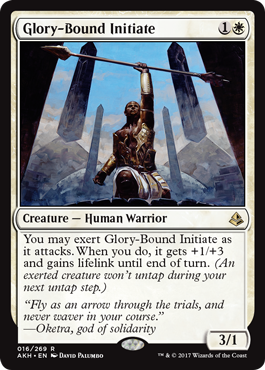
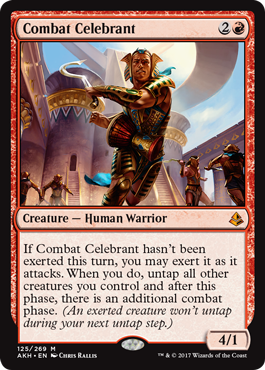
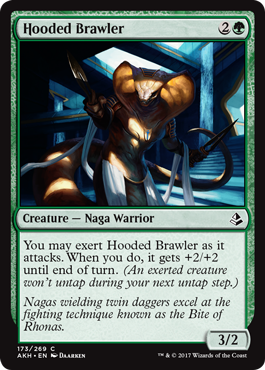
This was the origin of the exert mechanic. It appears on white, red, and green creatures (the three colors most focused on combat). The flavor is that you have the ability to exert your power over the creatures, making them push themselves a little harder than they should.
If I Had a Nicol . . .
And that is how we complemented the top-down Egyptian influences with the top-down Nicol Bolas influences. I hope you all enjoy how it all came together when you play in the Prerelease this weekend. As always, I am eager to hear your feedback on both today's column and the Amonkhet set. You can email me or contact me through any of my social media accounts (Twitter, Tumblr, Google+, and Instagram).
Join me next week as I begin to tell some card-by-card design stories of Amonkhet.
Until then, may you feel a little Bolas-y when you play at the Prerelease.
#426: Fights I Lost
#426: Fights I Lost
37:57
I often talk about the many fights in R&D that I managed to win. Well, I didn't win them all, and this podcast talks about a bunch of the fights I lost.
#427: Top-Down vs. Bottom-Up
#427: Top-Down vs. Bottom-Up
41:48
There was a lot of discussion online about what exactly "top-down" and "bottom-up" designs were, so I dedicate a podcast to talk all about what the terms mean.
- Episode 425 Lessons Learned: Battle for Zendikar (26.5 MB)
- Episode 424 20 Lessons: Don't Prove (32.4 MB)
- Episode 423 Virtual Tour (24.4 MB)

